Product Info Summary
| SKU: | A01865-1 |
|---|---|
| Size: | 100 μg/vial |
| Reactive Species: | Human, Mouse, Rat |
| Host: | Rabbit |
| Application: | ELISA, IHC, WB |
Customers Who Bought This Also Bought
Product info
Product Name
Anti-UGT1A1 Antibody Picoband®
View all Glucuronosyltransferase 1A1/UGT1A1 Antibodies
SKU/Catalog Number
A01865-1
Size
100 μg/vial
Form
Lyophilized
Description
Boster Bio Anti-UGT1A1 Antibody Picoband® catalog # A01865-1. Tested in ELISA, IHC, WB applications. This antibody reacts with Human, Mouse, Rat. The brand Picoband indicates this is a premium antibody that guarantees superior quality, high affinity, and strong signals with minimal background in Western blot applications. Only our best-performing antibodies are designated as Picoband, ensuring unmatched performance.
Storage & Handling
Store at -20˚C for one year from date of receipt. After reconstitution, at 4˚C for one month. It can also be aliquotted and stored frozen at -20˚C for six months. Avoid repeated freeze-thaw cycles.
Cite This Product
Anti-UGT1A1 Antibody Picoband® (Boster Biological Technology, Pleasanton CA, USA, Catalog # A01865-1)
Host
Rabbit
Contents
Each vial contains 4mg Trehalose, 0.9mg NaCl, 0.2mg Na2HPO4, 0.05mg NaN3.
Clonality
Polyclonal
Isotype
Rabbit IgG
Immunogen
E. coli-derived human UGT1A1 recombinant protein (Position: E316-H533).
*Blocking peptide can be purchased. Costs vary based on immunogen length. Contact us for pricing.
Cross-reactivity
No cross-reactivity with other proteins.
Reactive Species
A01865-1 is reactive to UGT1A1 in Human, Mouse, Rat
Reconstitution
Add 0.2ml of distilled water will yield a concentration of 500ug/ml.
Observed Molecular Weight
59 kDa
Calculated molecular weight
50433 MW
Background of Glucuronosyltransferase 1A1/UGT1A1
UDP-glucuronosyltransferase 1-1 also known as UGT-1A is an enzyme that in humans is encoded by the UGT1A1 gene. This gene encodes a UDP-glucuronosyltransferase, an enzyme of the glucuronidation pathway that transforms small lipophilic molecules, such as steroids, bilirubin, hormones, and drugs, into water-soluble, excretable metabolites. This gene is part of a complex locus that encodes several UDP-glucuronosyltransferases. The locus includes thirteen unique alternate first exons followed by four common exons. Four of the alternate first exons are considered pseudogenes. Each of the remaining nine 5' exons may be spliced to the four common exons, resulting in nine proteins with different N-termini and identical C-termini. Each first exon encodes the substrate binding site, and is regulated by its own promoter. The preferred substrate of this enzyme is bilirubin, although it also has moderate activity with simple phenols, flavones, and C18 steroids. Mutations in this gene result in Crigler-Najjar syndromes types I and II and in Gilbert syndrome.
Antibody Validation
Boster validates all antibodies on WB, IHC, ICC, Immunofluorescence, and ELISA with known positive control and negative samples to ensure specificity and high affinity, including thorough antibody incubations.
Application & Images
Applications
A01865-1 is guaranteed for ELISA, IHC, WB Boster Guarantee
Assay Dilutions Recommendation
The recommendations below provide a starting point for assay optimization. The actual working concentration varies and should be decided by the user.
Western blot, 0.1-0.5μg/ml
Immunohistochemistry (Paraffin-embedded Section), 0.5-1μg/ml
ELISA, 0.1-0.5μg/ml
Positive Control
WB: rat liver tissue, rat kidney tissue, mouse liver tissue, mouse kidney tissue
IHC: rat small intestine tissue, human rectal cancer tissue, mouse small intestine tissue, human mammary cancer tissue
Validation Images & Assay Conditions
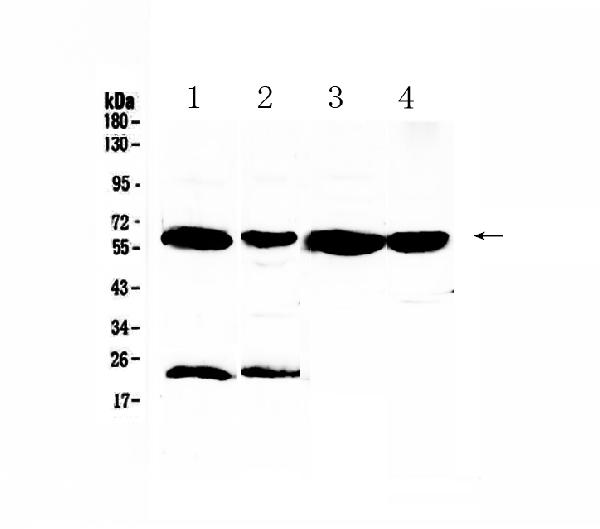
Click image to see more details
Figure 1. Western blot analysis of UGT1A1 using anti-UGT1A1 antibody (A01865-1).
Electrophoresis was performed on a 5-20% SDS-PAGE gel at 70V (Stacking gel) / 90V (Resolving gel) for 2-3 hours. The sample well of each lane was loaded with 50ug of sample under reducing conditions.
Lane 1: rat liver tissue lysates,
Lane 2: rat kidney tissue lysates,
Lane 3: mouse liver tissue lysates,
Lane 4: mouse kidney tissue lysates.
After Electrophoresis, proteins were transferred to a Nitrocellulose membrane at 150mA for 50-90 minutes. Blocked the membrane with 5% Non-fat Milk/ TBS for 1.5 hour at RT. The membrane was incubated with rabbit anti-UGT1A1 antigen affinity purified polyclonal antibody (Catalog # A01865-1) at 0.5 μg/mL overnight at 4°C, then washed with TBS-0.1%Tween 3 times with 5 minutes each and probed with a goat anti-rabbit IgG-HRP secondary antibody at a dilution of 1:10000 for 1.5 hour at RT. The signal is developed using an Enhanced Chemiluminescent detection (ECL) kit (Catalog # EK1002) with Tanon 5200 system. A specific band was detected for UGT1A1 at approximately 59KD. The expected band size for UGT1A1 is at 59KD.
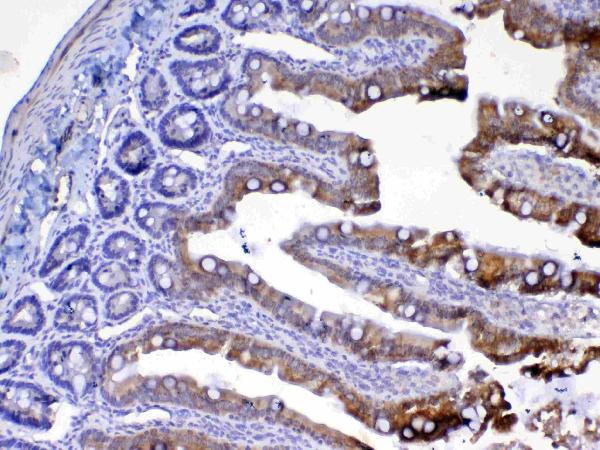
Click image to see more details
Figure 2. IHC analysis of UGT1A1 using anti-UGT1A1 antibody (A01865-1). UGT1A1 was detected in paraffin-embedded section of rat small intestine tissue. Heat mediated antigen retrieval was performed in citrate buffer (pH6, epitope retrieval solution) for 20 mins. The tissue section was blocked with 10% goat serum. The tissue section was then incubated with 1μg/ml rabbit anti-UGT1A1 Antibody (A01865-1) overnight at 4°C. Biotinylated goat anti-rabbit IgG was used as secondary antibody and incubated for 30 minutes at 37°C. The tissue section was developed using Strepavidin-Biotin-Complex (SABC)(Catalog # SA1022) with DAB as the chromogen.
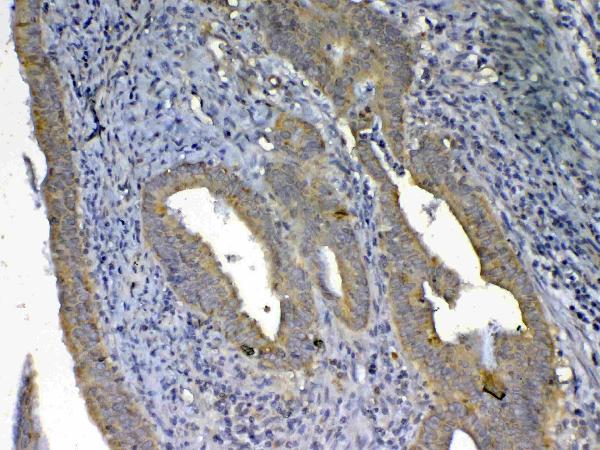
Click image to see more details
Figure 3. IHC analysis of UGT1A1 using anti-UGT1A1 antibody (A01865-1).
UGT1A1 was detected in paraffin-embedded section of human rectal cancer tissue. Heat mediated antigen retrieval was performed in citrate buffer (pH6, epitope retrieval solution) for 20 mins. The tissue section was blocked with 10% goat serum. The tissue section was then incubated with 1μg/ml rabbit anti-UGT1A1 Antibody (A01865-1) overnight at 4°C. Biotinylated goat anti-rabbit IgG was used as secondary antibody and incubated for 30 minutes at 37°C. The tissue section was developed using Strepavidin-Biotin-Complex (SABC)(Catalog # SA1022) with DAB as the chromogen.
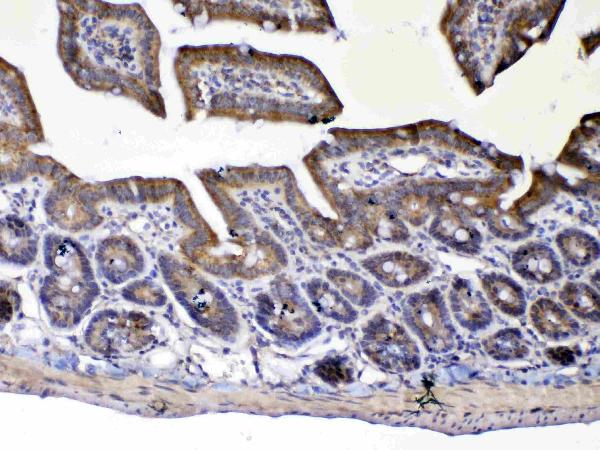
Click image to see more details
Figure 4. IHC analysis of UGT1A1 using anti-UGT1A1 antibody (A01865-1).
UGT1A1 was detected in paraffin-embedded section of mouse small intestine tissue. Heat mediated antigen retrieval was performed in citrate buffer (pH6, epitope retrieval solution) for 20 mins. The tissue section was blocked with 10% goat serum. The tissue section was then incubated with 1μg/ml rabbit anti-UGT1A1 Antibody (A01865-1) overnight at 4°C. Biotinylated goat anti-rabbit IgG was used as secondary antibody and incubated for 30 minutes at 37°C. The tissue section was developed using Strepavidin-Biotin-Complex (SABC)(Catalog # SA1022) with DAB as the chromogen.
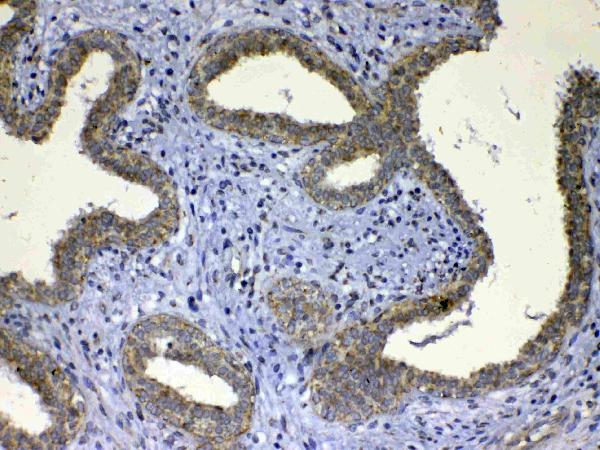
Click image to see more details
Figure 5. IHC analysis of UGT1A1 using anti-UGT1A1 antibody (A01865-1).
UGT1A1 was detected in paraffin-embedded section of human mammary cancer tissue. Heat mediated antigen retrieval was performed in citrate buffer (pH6, epitope retrieval solution) for 20 mins. The tissue section was blocked with 10% goat serum. The tissue section was then incubated with 1μg/ml rabbit anti-UGT1A1 Antibody (A01865-1) overnight at 4°C. Biotinylated goat anti-rabbit IgG was used as secondary antibody and incubated for 30 minutes at 37°C. The tissue section was developed using Strepavidin-Biotin-Complex (SABC)(Catalog # SA1022) with DAB as the chromogen.
Protein Target Info & Infographic
Gene/Protein Information For UGT1A1 (Source: Uniprot.org, NCBI)
Gene Name
UGT1A1
Full Name
UDP-glucuronosyltransferase 1-1
Weight
50433 MW
Superfamily
UDP-glycosyltransferase family
Alternative Names
UDP-glucuronosyltransferase 1-1; UDPGT 1-1; UGT1*1; UGT1-01; UGT1.1; Bilirubin-specific UDPGT isozyme 1; hUG-BR1; UDP-glucuronosyltransferase 1-A; UGT-1A; UGT1A; UDP-glucuronosyltransferase 1A1; UGT1A1; GNT1; UGT1 Ugt1a1|UDPGT 1-1, Udpgt, Ugt1|UDP glucuronosyltransferase family 1 member A1|UDP-glucuronosyltransferase 1A1|B1|UDP glucuronosyltransferase 1 family, polypeptide A1|UDP glycosyltransferase 1 family, polypeptide A1|UDP-glucuronosyltransferase 1 family member 1|UDP-glucuronosyltransferase 1-1|UGT1*1|UGT1-01|UGT1.1
*If product is indicated to react with multiple species, protein info is based on the gene entry specified above in "Species".For more info on UGT1A1, check out the UGT1A1 Infographic

We have 30,000+ of these available, one for each gene! Check them out.
In this infographic, you will see the following information for UGT1A1: database IDs, superfamily, protein function, synonyms, molecular weight, chromosomal locations, tissues of expression, subcellular locations, post-translational modifications, and related diseases, research areas & pathways. If you want to see more information included, or would like to contribute to it and be acknowledged, please contact [email protected].
Specific Publications For Anti-UGT1A1 Antibody Picoband® (A01865-1)
Hello CJ!
No publications found for A01865-1
*Do you have publications using this product? Share with us and receive a reward. Ask us for more details.
Recommended Resources
Here are featured tools and databases that you might find useful.
- Boster's Pathways Library
- Protein Databases
- Bioscience Research Protocol Resources
- Data Processing & Analysis Software
- Photo Editing Software
- Scientific Literature Resources
- Research Paper Management Tools
- Molecular Biology Software
- Primer Design Tools
- Bioinformatics Tools
- Phylogenetic Tree Analysis
Customer Reviews
Have you used Anti-UGT1A1 Antibody Picoband®?
Submit a review and receive an Amazon gift card.
- $30 for a review with an image
0 Reviews For Anti-UGT1A1 Antibody Picoband®
Customer Q&As
Have a question?
Find answers in Q&As, reviews.
Can't find your answer?
Submit your question
5 Customer Q&As for Anti-UGT1A1 Antibody Picoband®
Question
We appreciate helping with my inquiry over the phone. Here are the WB image, lot number and protocol we used for liver peripheral blood leukocyte using anti-UGT1A1 antibody A01865-1. Let me know if you need anything else.
Verified Customer
Verified customer
Asked: 2019-12-17
Answer
I appreciate the data. You have provided everything we needed. Our lab team are working to resolve your inquiry as quickly as possible, and we appreciate your patience and understanding! Please let me know if there is anything you need in the meantime.
Boster Scientific Support
Answered: 2019-12-17
Question
Do you have a BSA free version of anti-UGT1A1 antibody A01865-1 available?
Verified Customer
Verified customer
Asked: 2019-11-04
Answer
We appreciate your recent telephone inquiry. I can confirm that some lots of this anti-UGT1A1 antibody A01865-1 are BSA free. For now, these lots are available and we can make a BSA free formula for you free of charge. It will take 3 extra days to prepare. If you require this antibody BSA free again in future, please do not hesitate to contact me and I will be pleased to check which lots we have in stock that are BSA free.
Boster Scientific Support
Answered: 2019-11-04
Question
Here is the WB image, lot number and protocol we used for liver peripheral blood leukocyte using anti-UGT1A1 antibody A01865-1. Please let me know if you require anything else.
Verified Customer
Verified customer
Asked: 2019-10-29
Answer
Thank you very much for the data. Our lab team are working to resolve this as quickly as possible, and we appreciate your patience and understanding! You have provided everything we needed. Please let me know if there is anything you need in the meantime.
Boster Scientific Support
Answered: 2019-10-29
Question
We are currently using anti-UGT1A1 antibody A01865-1 for human tissue, and we are well pleased with the IHC results. The species of reactivity given in the datasheet says human, mouse, rat. Is it possible that the antibody can work on goat tissues as well?
Verified Customer
Verified customer
Asked: 2019-05-17
Answer
The anti-UGT1A1 antibody (A01865-1) has not been validated for cross reactivity specifically with goat tissues, though there is a good chance of cross reactivity. We have an innovator award program that if you test this antibody and show it works in goat you can get your next antibody for free. Please contact me if I can help you with anything.
Boster Scientific Support
Answered: 2019-05-17
Question
My question regarding product A01865-1, anti-UGT1A1 antibody. I was wondering if it would be possible to conjugate this antibody with biotin. I would need it to be without BSA or sodium azide. I am planning on using a buffer exchange of sodium azide with PBS only. Would there be problems for me to conjugate the antibody and store it in -20 degrees in small aliquots?
Verified Customer
Verified customer
Asked: 2017-06-22
Answer
It is not recommended storing this antibody with PBS buffer only in -20 degrees. If you want to store it in -20 degrees it is best to add some cryoprotectant like glycerol. If you want carrier free A01865-1 anti-UGT1A1 antibody, we can provide it to you in a special formula with trehalose and/or glycerol. These molecules will not interfere with conjugation chemistry and provide a good level of protection for the antibody from degradation. Please be sure to specify this in your purchase order.
Boster Scientific Support
Answered: 2017-06-22





